
|   |

|   |
Mulam 2023: A grounded Guru Shishya Parampara opens up possibilities - Ashwini Naik e-mail: ashwini.naik.gad@gmail.com Photos: Bhaskar July 22, 2023 This year, it was Mysore's turn to rehost the 8th edition of Mulam - The Roots, curated by Vyjayanthi Kashi, on 8th-9th July 2023. The event was co-hosted by Vyjayanthi Kashi's Shambhavi School of Dance and Mandya Ramesh's Natana Rangashaale. The focus of Mulam this year was to bring out the importance of Guru-Shishya Parampara as well as the mentor-mentee relations between Gurus and disciples. The first day of the event being dedicated to the mentor-mentee relations, Vyjayanthi Kashi brought together 3 artistes, Divya Warier, Pavitra Bhat and Namrata Mehta who have undergone an intense mentorship learning through the beautifully curated Pratiroop series by Warrier Foundation, to help the mentees conceptualise and choreograph independently. The seminar was moderated by Rohita Eswar, disciple and son of Guru Nandini Eswar. He is trained in Bharatnatyam, Kathak, Odissi, Kalaripayattu and is a Phd in Archaeology. He opened the day's event speaking of the importance of this seminar. Mulam is a word, that even when spoken reverberates inside us. It's a search for the journey of the Guru Shishya Parampara, which is very important for today's world to continue the legacy of the knowledge of our country. Like the Mulaadhara Chakra being the very seat of energy in yoga, Mulam also has been giving the experience, confidence, and energy to dancers. 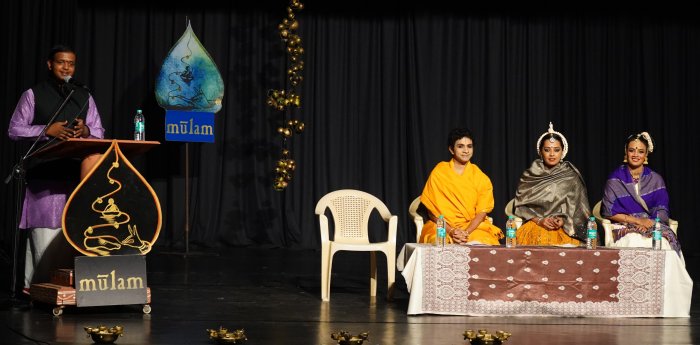 Rohita Eswar, Pavitra Bhat, Namrata Mehta, Divya Warier Mohiniattam dancer Divya Warier spoke of her journey in dance, when she started very young under a teacher who lived closeby. But as dance grew on her, she looked for a guru, and found her in Neena Prasad, under whom she delved deeper into Mohiniattam. But learning under her guru was not just about dancing; she also found the path in her life, as dance became more internalized. Every time she interacted with her guru a spark was ignited in her. This also sparked her thought to create the Pratiroop series to bring mentorship to fellow artistes too. As her mentor, she had Odissi Guru Sharmila Biswas who helped her think out of the box, modulate her body language, and bring out the nuances of Hidimba, the demoness wife of Bheema. Their relation had the constraints of time; hence patience was something that had to be left off unlike working with your own guru without constraints. Odissi dancer Namrata Mehta has been learning under her Guru Daksha Mashruwala since the age of 6. Her guru taught her not only to perform on stage, but also well in life. Her view is that a guru guides students with comprehensive knowledge, and she also encouraged Namrata to be a part of mentorship program and learn beyond. Namrata has been mentored by Kuchipudi Guru Vyjayanthi Kashi, who embellished and augmented the choreography with her views, while keeping the purity of the Odissi form. She believes that the learnings she got from the mentorship will live on through her dance journey forever. Bharatanatyam exponent Pavitra Bhat started learning at 4 with Vasundhara. He believes his parents are first gurus as his mom always made him practice first thing he came home, and his father took him to watch great performances and requested great masters to let his son watch them do workshops. The word 'Guru' brings vibrations all around. He believes a Guru dispels darkness and the guru's aim is to guide a student to realize himself. When he started learning under Guru Deepak Majumdar, he was taught first to copy the movements, then copy became memorizing and then memorizing became internalizing. Giving abundance of knowledge in its purest form, Majumdar shaped his life. Pavitra has toured with great masters later and this enhanced his skills and vocabulary of dance. He feels he was fortunate to get mentorship with Guru Neena Prasad. It was like a great learning experience to expand possibilities and give much more beautiful colours to what is already imbibed inside. Rohita summarized the thoughts of the three dancers very well and highlighted that they have become Sadhakas in the mentorship program. The Parampara hasn't vanished, but its course is changing. In cross mentorship the gurus made the mentees explore themselves and bring their ideas to life. Opening the second half of the day's celebration, Vyjayanthi Kashi spoke of her reasoning behind the event. Just like parents regularly talk to children of their grandparents to instil the culture and values of the family, it is important to have regular conversations to pass on the knowledge, cultural ethos and values the gurus have given us. As little children, the students may not understand these sentiments, but the more they spend time with gurus, and with maturity they begin to take more meaning out of the teachings. A guru also wants to have a good student who will carry the Parampara ahead. Mulam is her way of expressing her gratitude to the gurus and enable herself and more youngsters to hear from other performers of their gurus, with the intention to inspire this next generation to cherish, nourish and share the learnings. This was followed by the wonderful performances from the three young dancers who presented one choreography of their guru and one choreography which they created under the mentorship series guided by mentors. 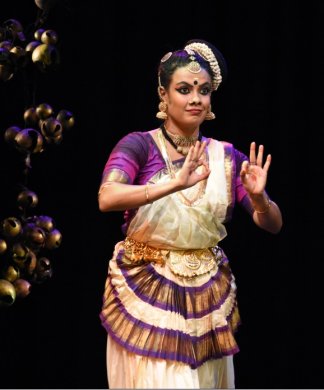 Divya Warier Divya Warier started off with her Mohiniattam recital with a traditional piece of her Guru Neena Prasad, which took us to the land of Kerala centuries ago. She followed it up with an excerpt from her production titled 'Hidimba - The lost lullaby', mentored under Guru Sharmila Biswas. This was based on Hidimba, the Yakshi and cannibal, beloved of Bheema, who has not been accepted or acknowledged much. She was a woman who put her self-need aside and gave birth and raised her son Ghatotkacha, as a weapon. The item started with her son interrupting his mother during her morning rituals. Divya very beautifully portrayed the mother and son bonding when he was a little child over small games, slowly Hidimba initiating him to build courage fighting a tiger, training him with martial arts, and instilling the knowledge of dharma in him. She built him up as a worthy warrior, only for him to be pulled into the war between the Kauravas and Pandavas and losing his life in the war. Her very emotional portrayal of the distraught mother, her cry for Bheema filled with her anguish, questioning the reasoning behind the war was a real stand out to her talent. Whose war, was it? And who lost? Her strong portrayal brought tears to the eyes of many in the audience. 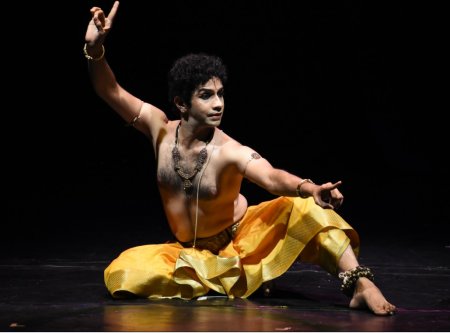 Pavitra Bhat Pavitra Bhat started his Bharatantayam performance with an excerpt from his production 'Krishnarth' under the guidance of Guru Neena Prasad who urged him to consider Krishna away from the standard angles of his leelas. His production focussed on Krishna reminiscing his journey as a human, his journey of love and devotion with Arjuna where he was also ready to take the role of a charioteer for him, and Krishna's journey as divine when he took the Virataroopa and resolved Arjuna's dilemma of his dharma. He is overwhelmed with losing his friend at his own end as human at the hands of a hunter. Pavitra handled the different roles of Arjuna and Krishna, and the emotions running through the characters at different stages of love, devotion, awe, and pain with great dexterity. He completed his performance with a traditional Brindavani Thillana, a choreography of his Guru Deepak Majumdar, enthralling the audience with his pure dance style.  Namrata Mehta Namrata Mehta first presented a traditional piece from her Odissi Guru Daksha Mashruwala. She followed it up with excerpts from her production 'Krishnamayi' under the guidance of Guru Vyjayanthi Kashi. Her production focused on the conversation between Radha and Krishna in heavenly abode. Radha, who has already left her mortal body, has been waiting for Krishna in the heavens, and having totally surrendered to her love, she has been trying to become him by also dressing up like him, and spending time in the forests lost in his thoughts. She suddenly hears Krishna in pain when he is hit by the arrow of the hunter and wakes out of her stupor and is surprised and emotional to see him in front. Krishna tells her that he has always missed her and shed tears in longing and asks if Radha felt the same. But Radha says, she never shed tears as she didn't want to lose Krishna who resided in her eyes. She offers Krishna his flute and they both dance to his music. The creatures around them are also now confused when they see them both together as to who is the real Krishna. But they identify the real Krishna seeing him in Radha's eyes. Her vachika bhava, calling out to Krishna, when she wakes out of her stupor hearing him in pain, greatly enhanced the portrayal of the deep emotions Radha felt and Namrata attributed this expression to the mentorship of Vyjayanthi Kashi. The ending was a little unusual from normal choreographies and very interesting because of its creativity, where Radha and Krishna were portrayed as the 2 parts of the same (similar to Ardhanareeshwara), to show their eternal union. Having been mentored by gurus from a different style than theirs, one could see the influence of the cross styles and the creative thought process inspired by the mentors, in the productions of the 3 young dancers. The evening concluded with honouring of the chief guests of the day, H .R. Leelavathi, well known singer of Kannada Light Music who has made a mark in every Kannadiga's heart, and Mandya Ramesh, a movie and theatre personality, and the founder secretary of Natana Rangashaale in Mysore which provides training in theatre for enthusiasts. Speaking to the audience, H.R. Leelavathi emphasized the importance of arts and the Guru-Shishya Parampara. Man as a social being, cannot live with only the basic necessities of food, shelter and family. He needs arts in his life to keep him entertained and educated. With such a need, there comes the need to also ensure the continuous survival and growth of arts, and the Guru-Shishya Parampara plays a strong role in this. With this background, she congratulated both Vyjayanthi Kashi and Mandya Ramesh for constantly striving to keep the art and Parampara alive with their unique contributions to the field of dance and theatre. The second day of Mulam 2023 was a grander celebration of the Parampara, what with having Karnataka's most celebrated literary figure, writer Dr. S.L. Bhyrappa as the main chief guest. Speaking at the event, Bhyrappa highlighted the importance of the Parampara. He remembered his introduction to classical dances during the period of writing his book Mandra. Being a lover of Hindustani music and dance, he also had the opportunity to watch Pandit Birju Maharaj and Saswati Sen's Kathak recital, the flavour of which can be seen in his book Mandra. He understands that music is like meditation and our dance is present in all Indian temples as sculptures, and he wishes that all dancers should visit these places to imbibe the aesthetics. He wished that more such celebrations of dance like Mulam can be conducted regularly so that the young students can be inspired, and more youngsters can get chance to perform their art. He also wished that people would take more interest in the dances and music and promote them, than being lost in the everyday struggles. 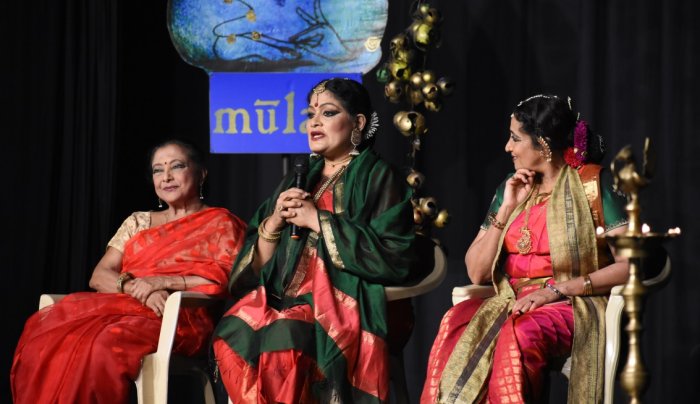 Saswati Sen, Geeta Chandran, Vyjayanthi Kashi This was followed by a seminar on the impressions of mentoring young dancers and the importance of Guru-Shishya Parampara as felt by our senior Gurus and dancers -Bharatanatyam exponent Geeta Chandran, Vyjayanthi Kashi, and Kathak exponent Saswati Sen. Speaking of her experience with her gurus, Geeta Chandran said that they believed that the teachers were the ultimate. She started as student of Swarna Saraswati who was known as Abhinaya Saraswati and looked at dance as seva to god, and was also an accomplished musician. She inspired everyone to understand importance of music and its resonance in dance. Later Geeta went on to learn from K.L. Dakshinamurthy who was a performer. This was a new approach to dance. She then learnt under Jamuna Krishnan, who brought the modern Indian women's approach to dance and later with Kalanidhi Narayanan. These differing experiences have helped her understand the difference between craft and skill. Craft is easy to acquire, but skill is only in the hands of the performer, and this intangible skill is what she believes is Mulam. We are different from westerners as our dance has soul, we can create magic just standing on stage and with just one glance. We need to bring back that stillness and intensity in dance, that spirituality in dance. When she started teaching all first-generation dancers, she first had to set the foundation and context for dance, its history, philosophy, mythology, poetry, music. Her Natya Vriksha was set up to provide this cross knowledge, without which we cannot be a complete artiste. Of cross mentorship, she believes that the dancers need a wide understanding of Natya to be able to cross-mentor or absorb the essence of mentorship they receive. She also said that we need to stay on course of what we learn and not get distracted by the innumerable amount of data/videos we have at our fingertips and divert away from the core practice. Vyjayanthi Kashi, who started her initial training in Bharatanatyam under Guru Ramanna, believes that she was lucky to experience Guru-Shishya Parampara, as her gurus came over to her home, stayed there and taught her 1-1. Her Guru had in his mind a goal to make her a finest dancer. The perfection he instilled in her still stays with her. As Shankaracharya says, to accept someone as a shishya, the student needs at least two basic qualities, patience and commitment to learn, unlearn and re-learn. Also as Krishna says in the Bhagavad Geeta in "Abhyasena Kaunteya!....", the mind is the toughest to control, and it is only with abhyasa or continuous practice that all difficult things can be overcome and the ultimate achieved. When she went to learn Kuchipudi under Guru Vedantam Prahalada Sharma, she was presented the gejje (ghungroo) that had 3 strands of bells with knots in-between them. Her guru explained that the 3 strands of bells represented the Rig Veda, Sama Veda, and Yajur Veda, and the knots in between represented the Atharvana Veda. The knots at the end represent the guru giving and the shishya or student receiving, and only when these knots come together, the learning becomes heart-to-heart. This needs love, respect, trust, and faith in each other. The guru knows what to give, when and how much, to the shishya. She insisted that learning from a performing guru, like she learnt from Korada Narasimha Rao, is a beautiful experience that teaches the nuances of navigating and presenting self on stage with confidence and grace. You need to spend at least 20-25 years under a guru to really learn, copying initially maybe, but later taking the philosophy behind to go deeper and deeper. This foundation with a guru can help you to take a mentorship or masters or any learning with another teacher. Quoting a Subhashita, she explained that to be a complete dancer, we need 25% talent, 25% samskara or culture, 25% practice and 25% learning under a guru. Having the first 3 doesn't guarantee in being a good artiste, but just having the 25% guru's blessings can gain you all the other 3 aspects. It was now Saswati Sen's turn to speak of her journey and learnings. She came from a non-musical family with no dancers. It was when she migrated to Delhi, she got introduced to dance. She started learning dance under Lepa Chatterjee, who gave her a lot of love and care. Her teacher's efforts also resulted in her introduction to her Guru Birju Maharaj under whom she went on to learn further. Watching Maharaj-ji dance or teach was a revelation. She was inspired by Maharaj-ji's abhinaya in every movement of dance. When asked, Maharaj said that he doesn't believe he ever dances alone, but always danced with Krishna around him and this meant expressing his emotions towards Krishna in every movement. Dancing is not just about movements but a sadhana to reach the divine. Maharaj-ji, who was accomplished in multiple disciplines, believed that if you understand one thing deeply you can understand many other disciplines. Having experienced and understood the respect, especially from westerners, for her knowledge of dance, she encouraged youngsters to not consider dance as secondary. She insisted that they need to focus on the art and believe in their guru to lead them. As a teacher herself, she has had to learn to adapt to the changing world. She quoted a couple of examples of how today's children interpret the dance movements very differently from their elders, as they haven't known those circumstances the elders have seen. Hence imparting the concepts and background is also very important.  Geeta Chandran The thought provoking seminar was followed by the much awaited performances by the 3 experienced artistes. Geeta Chandran started her Bharatanatyam recital with Govinda vandana, celebrating Krishna as both Jishnu, the invincible, and Trishnu, the fearless. She celebrated the beautiful one who rests on a snake, who gave Geetopadesha to Arjuna, whose flute mesmerizes all Gopis and animals and who is the beloved of Rukmini, the one who helps us cross the Samsaara Saagara. But the highlight was her recital on the Daanava king Ravana, bringing out his various emotions when he goes to meet Sita at Ashokavana, ensuring he dresses up to impress her. His awe when he sees her beauty turns to huge frustration when Sita rejects him repeatedly. Geeta's subtle expressions but strong portrayal enthralled audiences bringing out an expression of wonder when it was over. 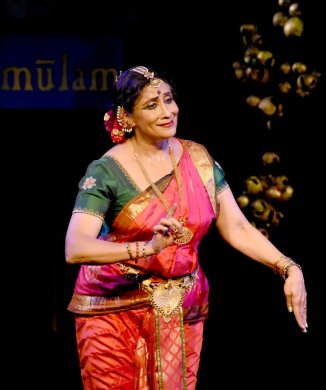 Vyjayanthi Kashi This was followed by a power-packed Kuchipudi choreography by Vyjayanthi Kashi titled 'Sharmisthe - destiny is the ultimate' which she had particularly chosen as it was the last piece choreographed under the guidance of her late Guru Korada Narasimha Rao. The abhinaya packed choreography conveyed Sharmishte's pride and attitude as a princess, her love for her friend Devayani, the anguish of hurting her friend in a rash moment of anger, and her pain when insulted to be her friend's handmaid for life. Sharmishte finds love but loses her friend again when she marries Yayati, Devayani's husband, leading to his curse. Yayati requests his sons to come forward and help him reverse the curse of losing his youth by taking the curse on themselves. It is only Sharmishte's son Puru who offers himself and loses his youth. Sharmishte is shocked at her husband's selfishness of wanting to enjoy life more and more, and not hesitating to grab it from his young son who is yet to see life. She is dejected at all the worldly pleasures and gives up everything to take the path of renunciation. Vyjayanthi Kashi portrayed the varying emotions of Sharmishte across her life keeping the audience attention continuously glued to her performance.  Saswati Sen Saswati Sen began her Kathak recital with 'Krishna Keerthan' celebrating Krishna in Vrindavan, showcasing the little Krishna's playful leelas with her sweet expressions. She proved that age is no barrier, with her short nritta based on Kathak patterns, when she took 12 chakkars gaining the audience's ovation. She followed it with 'Ahalya Udhar' where she demonstrated multiple roles and the use of angavastram to highlight the characters. Next was the beautiful portrayal of shringara rasa of Radha as the Swadheenapathika Naayika in the ashtapadi. She concluded her performance with a short Tarana. At the end, the audience was left wishing for more. Bharatanatyam exponent Thulasi Ramachandran who was the chief guest, spoke at the event and highlighted the varying portrayals of the 3 dance stalwarts and said that this is possible only when you really understand and get into the character. This Mulam has inculcated that fire in the young dancers to express themselves and imbibe the qualities that need lot of practice and patience. This year's Mulam was supported by Ministry of Culture, Kannada and Culture Secretariat and Warrier Foundation. Looking forward to more versions of Mulam in the coming years.  Ashwini Naik is a corporate leader, dance enthusiast and an amateur writer. Vice President in a Multinational, Ashwini tries to intertwine her vocation and avocation by driving cultural initiatives in the corporate world. Having trained in Bharatanatyam and Kuchipudi, Ashwini shares her learnings of leadership qualities from dance with her corporate friends. |